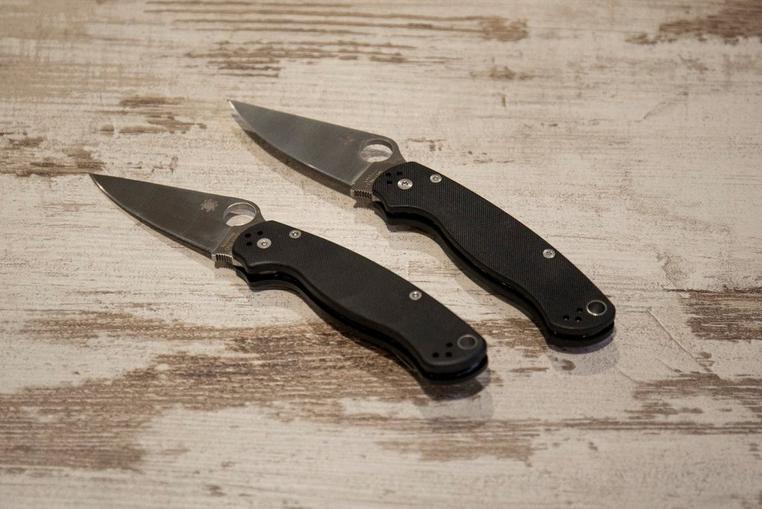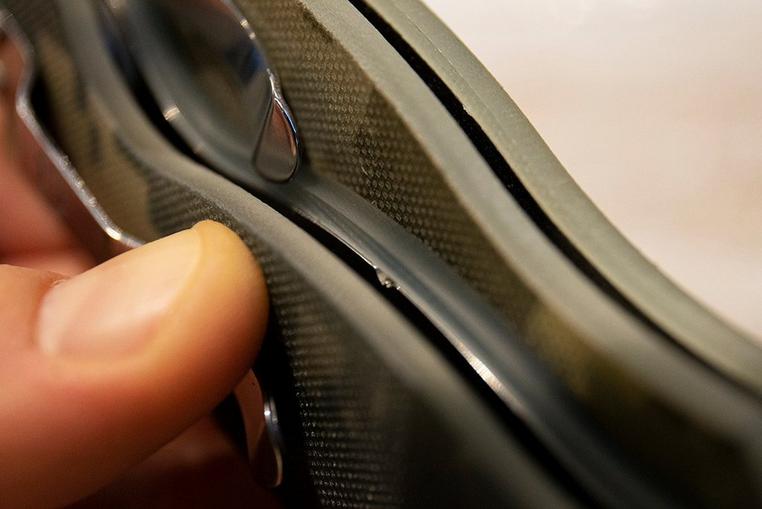Counterfeit knives: what is the deal with those?
We see them more and more often: counterfeit knives. In China you can purchase knives for a very small price that looks like the famous knives from renowned brands. Clones, counterfeits or fakes: all bad news. How is this possible? What are the differences? How do you recognize them? Knivesandtools explains!
What is a counterfeit knife?
A counterfeit knife is a knife that was made to closely resemble an existing model, including markings. Everything is done to make sure the product looks as 'real' as possible. Still, it's never 100% the same. People also call these types of knives 'clones' or '1:1', terms you often come across on forums.
What the quality of counterfeit knives?
That is difficult to say. There are namely knives of appalling quality, which pose an immediate risk to the user. But there are also knives that, at first glance, are not that different from the original. Where the brand markings are even 99% similar to the originals.
Which knives are counterfeit?
We have seen knives from many different brands that were counterfeit. Some brands that stand out are: Spyderco, Zero Tolerance, Fällkniven, LionSteel, Benchmade, ESEE and Cold Steel. Often models that are already popular, so that there is as much demand for the counterfeit version as possible.
Where do counterfeit knives come from?
We can safely say that all counterfeit knives come from Asia, mainly from China. Sometimes people whisper that there are counterfeit knives that are produced in the same factory as where the original is produced. We dare to say that that is almost never the case. We were, at least, never able to prove it.
Brands that would sell their own knives on the black market would simply be throwing money out of the window. On the one hand they break down their own legal trade by selling their knives for a lower price on the black market. On the other you break down your own brand because people can no longer rely on the authenticity of your products.
In addition, renowned brands spend a lot of time fighting counterfeit goods. One of the brands that is often copied is Spyderco. Spyderco director Eric Glesser told us that he spends quite a lot of time fighting and suing the individuals selling counterfeits. Spyderco even sued eBay because they don't do enough to combat the sale of counterfeit goods. Spyderco and eBay settled this matter, after which eBay changed its policy.
What about homages?
There is also a category that, by some, is called an 'homage' or 'tribute'. A model that strongly resembles a specific model of another brand, but without copying the brand markings. With these models you can also clearly tell that someone is not trying to pretend that the knife is made by the original brand. Highly debatable, but already relatively normal in the watch industry.
How can counterfeit knives be so cheap?
Now, of course, the question arises how it is possible that counterfeit knives are so similar to the original knives, but often cost only a fraction of the price. It is the result of a number of factors. Do they use the same materials? What about the heat treatment?
Manufacturers of counterfeit knives have a couple of advantages: they don't put any time into research and development. Or in how they should protect their designs. No money is spent on patents or licences for designs on the original designer of the knife. Are the employees who produce these counterfeit knives taken care of? The producers of a counterfeit product also don’t have to spend money on marketing, fairs, representatives or intermediaries. They also don't have to think about warranties. Read more about how a pocket knife is given its price.
If such a knife closes when you don't want it to, you are lucky to be left with only a couple of stitches...
What are the risks of counterfeit products?
First you know nothing of the construction quality. You can easily reproduce a knife, but the nuances in the adjustment of a lock can be lost when copying the design. If such a knife closes when you don't want it to, you are lucky to be left with only a couple of stitches...
You also don't know anything about the use of materials. You can easily engrave CPM S30V into a blade, but who will tell you that is real? What about the heat treatment? Corrosion resistance? Risk of breaking? All question marks.
As such you have no warranty at all. You cannot purchase spare screws and you also don't have to count on the help of an authorized seller.
You are infringing the intellectual property of an original manufacturer and designer. Imagine that you have worked your entire life developing a design and production process. Building a brand with a good reputation. You might work 80 hours a week to keep your business going. And then you come across someone who says: I will simply copy this and keep everything I earn. You'll feel pretty screwed. Bad karma as well.
You also make a mockery of the whole 'pride of ownership'. Imagine you spent a lot of time saving up to purchase an expensive knife. When you finally do you will feel great and proud of what you accomplished. We know you won't feel the same when you purchase a counterfeit product worth next to nothing. In addition, that expensive knife will still have a great value on the second-hand market. When you offer a counterfeit product up for sale you are liable.
What does Knivesandtools do against counterfeit goods?
We only buy from renowned brands and their distributors. As such we know for sure that we only receive legal, real products with a valid factory warranty.
Products that are returned by customers are properly checked by at least two people. As such we know for sure that we do not receive counterfeit knives. Throughout the years we have become quite experienced when it comes to counterfeit knives, and can quite easily pick them out of a line up. We even know the weak spots of the models that were copied really well. It is how we know for sure that no counterfeit products end up in our stock.
Fortunately the price will then tell you enough: $50 for a Zero Tolerance knife is always too cheap.
What can you do against counterfeit goods?
The first is quite obvious: only buy from reputable dealers. We do whatever we can to prevent counterfeits, and have had an excellent reputation in this field for over 20 years. In addition, we can help you make the right choices.
Avoid deals that are too good to be true. Think of ads on second-hand sites that are too cheap for the product that is offered up for sale. Also, when you purchase a second-hand knife, try to pick up it up and compare it to pictures of the real product. We make all our product photographs ourselves, so you can easily use those as a reference.
Also, if you come across a disputable ad, check if you can find exactly the same photographs on Asian second-hand sites. Some second-hand sellers don't even take the time to take care of their own photographs, but directly take their pictures from the site where they purchased their counterfeit products. We do, however, have to mention that some sellers are so cunning as to use the photographs of an original product for a counterfeit knife. Fortunately the price will then tell you enough: $50 for a Zero Tolerance knife is always too cheap.
Don't purchase clones yourself! It sounds so simple, but by 'trying' to see if a knife is really that bad you keep the trade alive! And what do you do with the counterfeit product? Give it away with the risk that it contains a production flaw? Too bad when your nephew loses a finger because the lock fails...
How do you recognize counterfeit products?
Compare the counterfeit product with the photographs or, if possible, with the original product. Often there are subtle deviations in the engraving on the knife. A lot of attention is often paid to the design of the knife. That is why it is extra interesting to look at the inside of the handle. Some knives have a characteristic dent or nod in typical places, something that is missing on the counterfeit product.
Details such as how the jimping on the spine of a blade are milled also tell you a lot. Even though the packaging was quickly exchanged, fake packaging is also a great indicator. Some manufacturers use specific boxes to wrap their knives in. Boxes with a specific colour and lining. So if you come across a box with a different colour than the original you know you are being fooled.
Also closely look at the surface finish of specific parts. If the satin finish on the blade is coarser or finer this could be an indicator. You could also take a close look at the screws. It might not always be definitive, but if you have a couple pieces of the puzzle you can come to the a certain conclusion.
We do have to note one thing: manufacturers do regularly change details, packaging, colours, logo or finish. Often without mentioning it to us. The product might appear to deviate, but it is simply a newer batch. We, for instance, experienced that a manufacturer wrote a clear article about how the packaging of a specific knife should look like to make sure it wasn't a fake. Reality, however, taught us that they would first sell out the old boxes that didn't completely fit that image. This also directly demonstrates how difficult this matter is.
Even if someone has tens of thousands of followers on Youtube: it doesn't mean he is right.
Don't believe everything you hear or read online
Some reviewers claim in videos, on blogs or in Facebook groups, that they know for sure that a product is fake based on one detail. While in fact they only have one or two copies to make a comparison. Then it is often a slightly different version of the packaging. Or a manufacturer updated the logo. Or something was improved in the production process which is why the edge is nice and rounded. It definitely doesn't mean that a product is fake. Moreover, we can look at our stock, where we sometimes have the luxury of comparing ten copies, and find out that all new stock from a manufacturer was given that update. Even if someone has tens of thousands of followers on Youtube: it doesn't mean he is right.
Conclusion
Counterfeit knives are a big problem in the knife world, but together we can fight them. Don't purchase them and spread them out when you come across one. If you are in doubt when you find a great deal on a second-hand website because the price is really, really good? If you are, chances are it really is too good to be true.






?%24center=center&%24poi=poi&%24product-image%24=&fmt=auto&h=500&poi=%7B%24this.metadata.pointOfInterest.x%7D%2C%7B%24this.metadata.pointOfInterest.y%7D%2C%7B%24this.metadata.pointOfInterest.w%7D%2C%7B%24this.metadata.pointOfInterest.h%7D&scaleFit=%7B%28%24this.metadata.pointOfInterest%29%3F%24poi%3A%24center%7D&sm=c&w=1208)



